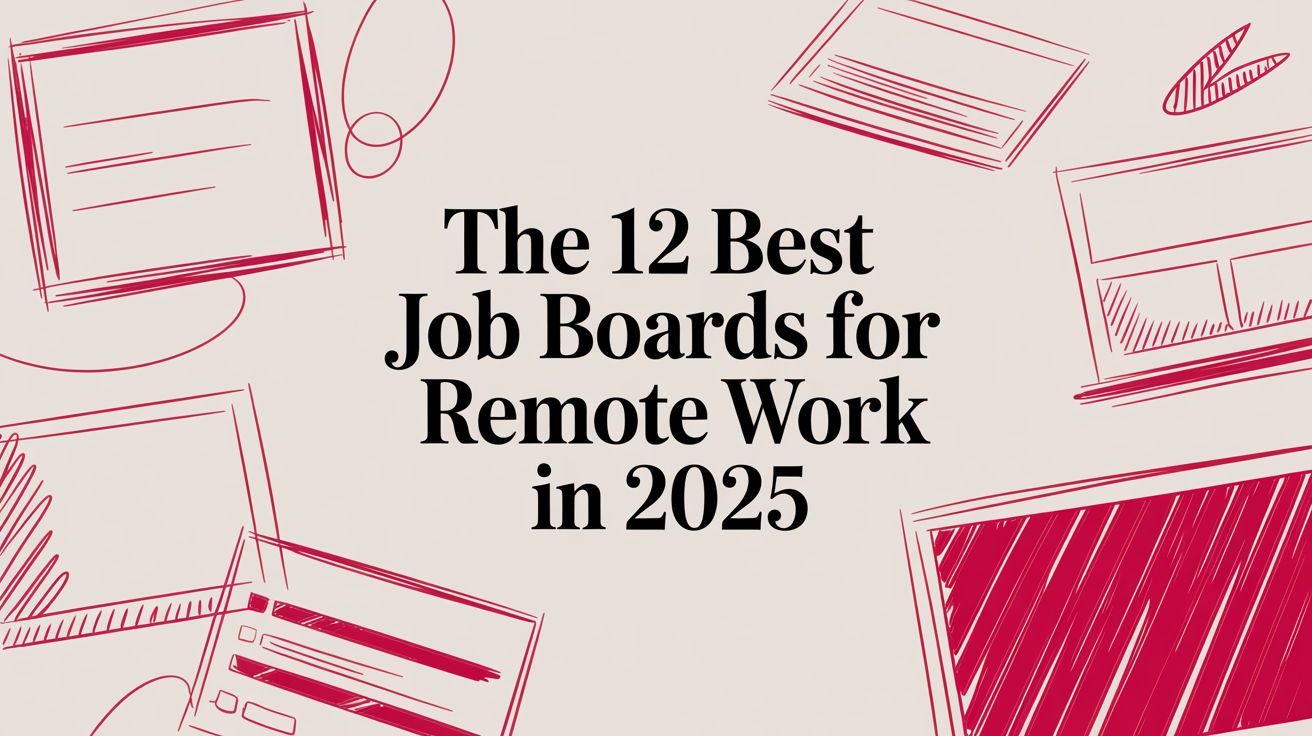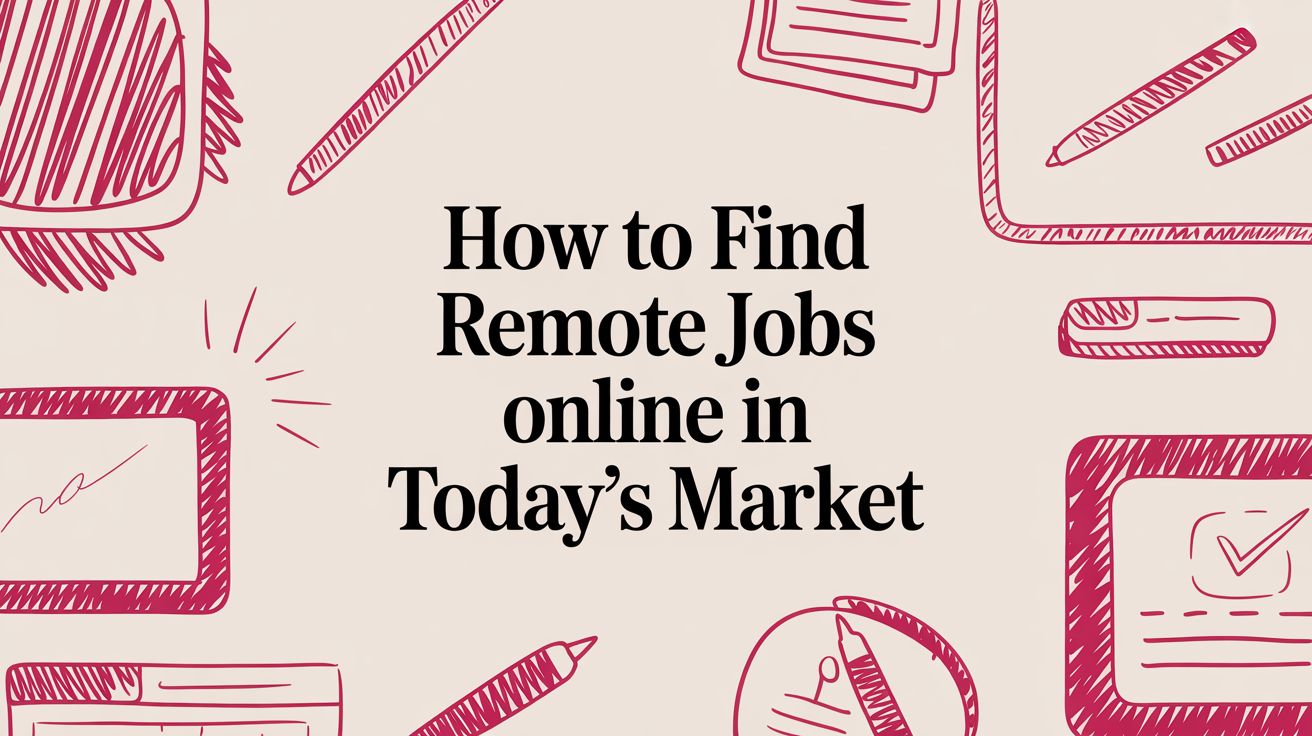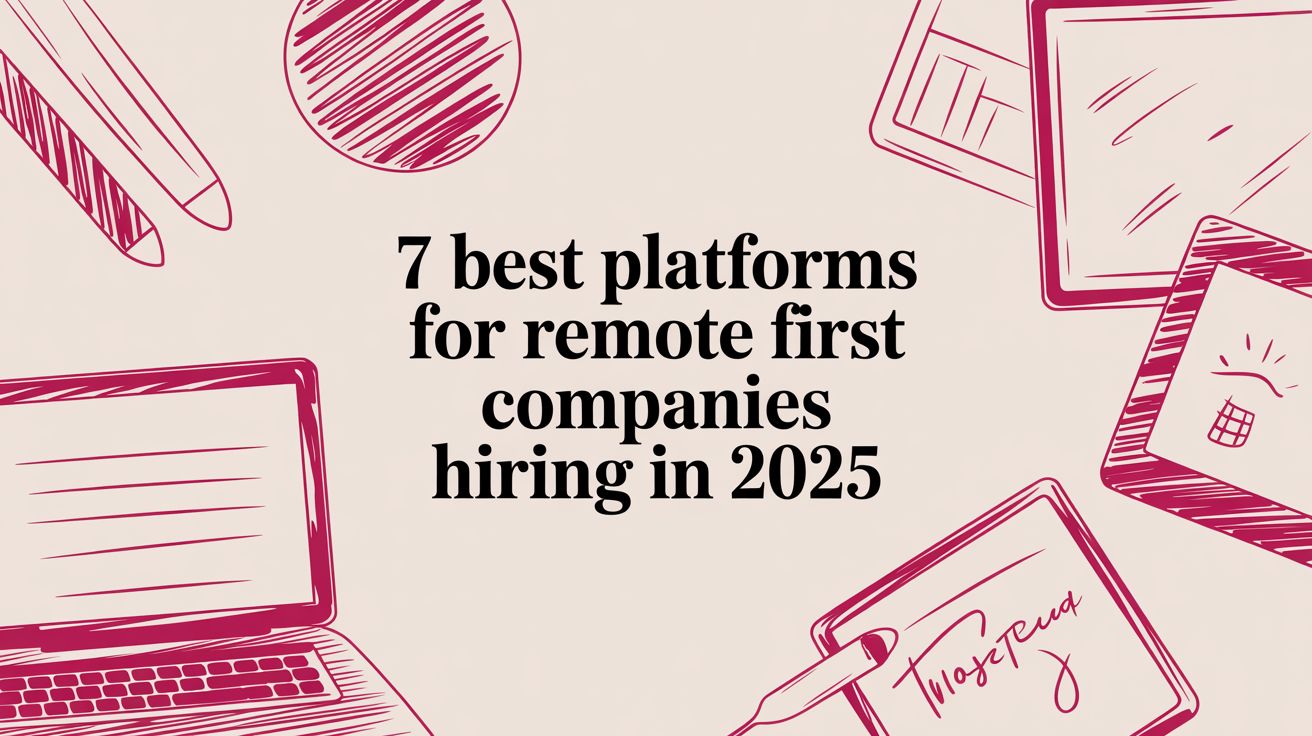Landing a great remote job isn’t about blasting your resume into the void. It’s about a focused strategy: optimizing your online presence for remote-specific skills, zeroing in on the right job boards, and tailoring every single application to show you can crush it without someone looking over your shoulder. Think quality over quantity.
Navigating the New World of Remote Work

Let’s be real. Finding a remote job today is a completely different game than it was just a few years ago. What used to be a niche perk has exploded into a core expectation for a huge part of the global workforce.
This shift is a double-edged sword. On one hand, there are more opportunities than ever before. On the other? The competition is fierce. You’re no longer just up against local candidates; you’re competing with talented professionals from all over the world. The old job search playbook just won’t cut it anymore.
The Remote Work Boom Is Here to Stay
This isn’t just a feeling; the numbers back it up. By 2025, an estimated 36.2 million Americans are projected to be working remotely. That’s a staggering 87% jump from pre-pandemic levels. Clearly, the demand for flexibility isn’t going anywhere.
While this has created a ton of options for job seekers, it’s also made employers much more discerning. They’re looking for proof that you’re a self-starter, a killer communicator, and organized enough to manage your own time without needing a manager down the hall.
Experienced remote workers know that success isn’t just about having the right skills for the job; it’s about demonstrating you have the right work ethic and habits for remote life.
What This Means for Your Job Search
Your approach needs to be deliberate. Every piece of your job hunt—from your LinkedIn profile to your interview answers—has to be viewed through a remote-first lens. To stand out, you need to nail these three things:
- Showcase Your Remote-Ready Skills: Don’t just list your job duties. Emphasize your experience with asynchronous communication, time management, and working autonomously.
- Build a Rock-Solid Digital Presence: Your online profiles are the new first impression. Make sure they’re polished, professional, and tell a compelling story.
- Target the Right Platforms: Stop wasting time on generic job boards. Focus your energy on sites that are dedicated to remote and flexible roles.
Before we dive deeper, it’s worth getting your own house in order. Staying organized during a job search is non-negotiable. Many pros discover Notion templates for ultimate productivity to keep everything from applications to interview notes in one place. And if you’re still weighing the pros and cons, our deep dive into the benefits of remote work is a great place to start.
To help you get started, I’ve put together a quick-glance table of the core actions we’ll be covering. Think of this as your roadmap for the rest of the guide.
Your Remote Job Search Quick Start Guide
Here is a quick summary of the core steps to kickstart your remote job search, giving you a clear roadmap for the rest of this guide.
| Action Step | Why It’s Critical for Remote Success |
|---|---|
| Optimize Digital Profiles | Your online presence (LinkedIn, portfolio) is your first interview. It must scream “remote-ready professional.” |
| Master Niche Job Boards | Generic sites are a black hole. Niche boards connect you directly with companies actively seeking remote talent. |
| Tailor Every Application | A generic resume gets ignored. Customizing for each role shows you’re a serious, attentive candidate. |
| Highlight Soft Skills | Prove you’re an excellent communicator, self-starter, and problem-solver—skills essential for thriving independently. |
| Prepare for Video Interviews | Your tech setup, background, and on-camera presence are just as important as your answers. |
| Follow-Up Strategically | A thoughtful follow-up keeps you top-of-mind and reinforces your professionalism and genuine interest. |
Following these steps will fundamentally change how you approach your job search, moving you from a passive applicant to a standout candidate that remote companies are eager to talk to. Let’s get into the specifics.
Building a Profile That Shines Remotely

When you’re applying for remote jobs, your online presence isn’t just a formality—it’s everything. Long before you ever get on a call, a hiring manager has already checked out your LinkedIn profile, skimmed your resume, and maybe even glanced at your portfolio.
This is your first, and often most important, chance to show you’ve got the goods to thrive without someone looking over your shoulder. Your goal is to create a profile that doesn’t just list what you’ve done but practically shouts, “I’m a remote-ready professional.”
Reframe Your Experience for Remote Roles
Here’s a little secret: you don’t need a history of remote jobs to land a remote job. The real trick is to reframe your in-office accomplishments to highlight the skills that remote companies value most—things like autonomy, self-management, and asynchronous communication.
Think about it. Your past roles are packed with moments where you demonstrated these exact skills. You just need to translate them.
Let’s look at a quick “before and after” makeover for a resume bullet point:
- Before: “Responsible for managing project timelines and coordinating with team members.”
- After: “Independently managed project milestones using Asana, ensuring all deliverables were completed on time in a fast-paced environment with minimal oversight.”
See the difference? The “after” version is so much stronger. It names a specific tool (Asana), emphasizes independence (“independently managed”), and proves you can deliver without hand-holding. This simple tweak directly addresses a hiring manager’s biggest concerns. You can dig into more of these strategies in our guide on the best way to find remote jobs, which is full of tips for aligning your experience with what companies want.
Optimize Your LinkedIn Profile Headline
Your LinkedIn headline is incredibly valuable digital real estate. Please, don’t waste it by just listing your current job title. It’s your personal billboard—use it to broadcast your top skills and the kind of role you’re targeting.
Key Insight: Treat your LinkedIn headline like a mini-advertisement for yourself. It should be keyword-rich and immediately tell a recruiter who you are and what you do.
Here’s how a small change can make a huge impact:
| Generic Headline | Optimized Headline |
|---|---|
| Marketing Manager at ABC Corp | SEO & Content Marketing Manager |
| Software Developer | Full-Stack Developer (React, Node.js) |
The optimized headlines are doing some heavy lifting. They’re packed with keywords recruiters are actively searching for, making your profile more discoverable. Plus, they instantly signal your specific expertise and your interest in working remotely.
Showcase Your Work with a Portfolio
A resume tells a story, but a portfolio shows the proof. This is non-negotiable if you’re in a creative or technical field like design, writing, development, or marketing. A clean, straightforward portfolio is one of the most powerful ways to demonstrate your talent.
It doesn’t need to be fancy. A simple website with a handful of your best projects will do the trick. For each project, just make sure to include:
- A quick summary of the challenge or goal.
- The specific actions you took to address it.
- The measurable results or impact of your work.
This structure proves you’re more than just a doer; you’re a strategic thinker who understands how your work contributes to the bottom line. It’s the tangible evidence that you can deliver incredible results from anywhere.
Finding Opportunities on the Right Platforms
Knowing where to look is half the battle. If you’re just blasting your resume out on massive, generic job boards, you’re setting yourself up for a whole lot of frustration. The smart move? Zero in on the platforms where genuine remote-first companies are actually posting jobs.
This means looking past the usual suspects and getting familiar with niche sites and job boards built specifically for remote work. These platforms are designed for people like you, with filters that really matter—like time zone overlap, whether a company provides equipment, and if a role is truly work-from-anywhere.
Go Beyond the Obvious Job Boards
Your search strategy needs to be a bit more creative than just hitting “apply” on repeat. While the big-name sites can be a starting point, the real gems are often tucked away on specialized platforms that actually vet their listings. This is how you avoid the “remote for now” roles and find companies that are truly committed to distributed work.
Here’s where you should be focusing your energy:
- Remote-First Job Boards: This is your home base. Sites like FlexJobs, We Work Remotely, and of course, our own Remote First Jobs are fantastic because they only feature remote positions. They do the first round of filtering for you.
- LinkedIn with a Twist: Don’t just mindlessly scroll the jobs tab. Get strategic. Use LinkedIn’s search to find people with titles like “Head of Remote” or recruiters at the companies you’re dying to work for. A thoughtful, well-written connection request can open doors that a simple application never will.
- Industry-Specific Communities: Are you a developer? Then you should be on Stack Overflow Jobs. A designer? The Dribbble job board is where you’ll find employers who speak your language. These niche sites attract serious companies looking for specific, high-level skills.
This targeted approach helps you search smarter, not harder. You can also give yourself an edge by checking out our guide on the best certifications for remote jobs to see which credentials might make your profile pop on these platforms.
A Comparison of Top Remote Job Platforms
To help you navigate the options, here’s a head-to-head look at some of the best job boards for remote work. Each has its own flavor, focusing on different industries, features, and pricing models. Finding the right mix for your search is key.
| Platform | Best For (Industry/Role Type) | Key Feature | Cost |
|---|---|---|---|
| Remote First Jobs | Tech, Marketing, Customer Support, Ops | Curated, high-quality listings from truly remote companies. | Free for job seekers |
| FlexJobs | Wide range of industries, including non-tech roles | All jobs are hand-screened for legitimacy and flexibility. | Subscription-based |
| We Work Remotely | Primarily Tech and Startups | One of the largest and most established remote job communities. | Free for job seekers |
| All industries, professional networking | Powerful search filters and direct access to recruiters. | Free (Premium optional) | |
| Dribbble | Design and Creative Roles | Niche board for designers to find roles at product-led companies. | Free for job seekers |
| Stack Overflow Jobs | Software Development, Engineering | Connects developers with top tech companies. | Free for job seekers |
Choosing one or two primary platforms and supplementing with a niche board is a solid strategy. Don’t spread yourself too thin—focus on quality applications over quantity.
Set Up Your Search for Success
Once you’ve picked your platforms, it’s time to make them work for you. Don’t just passively scroll through listings every day. That’s a recipe for burnout. Instead, take control by setting up smart alerts and filters that bring the perfect roles directly to your inbox.
For example, on most sites, you can create alerts for keywords that signal a true remote culture, like “asynchronous,” “distributed team,” or “work from anywhere.” This simple trick helps you weed out companies that are just remote-friendly and find the ones that are remote-first.
Pro Tip: Pay close attention to time zone requirements when you’re filtering. A “remote” job that needs you online during Pacific Standard Time isn’t going to work if you’re based in Europe. Being honest with yourself about this upfront will save you countless hours.
This kind of strategic filtering is more important than ever. The market is fierce. According to recent remote work trend data from Aura, remote or hybrid roles snagged 60% of all job applications but only made up about 20% of total job postings.
The competition is most intense in sectors like professional services (24.3% of remote jobs) and technology (18.3%). By focusing your search on the right platforms and the roles that truly match your skills and lifestyle, you stop being just another applicant in the pile and start becoming a serious contender.
Crafting Applications That Break Through the Noise

When hundreds of people are gunning for the same remote role, a generic resume is a one-way ticket to the “no” pile. The applications that actually get noticed don’t just list skills—they show the company exactly how you’ll solve their problems before you even get the job.
This isn’t an exaggeration. The competition is fierce because the demand is massive. Surveys show a staggering 91% of employees want to work remotely at least some of the time. That preference sends a flood of applicants to every flexible company out there.
Your mission is to craft a story that proves you’re not just another applicant, but a proactive problem-solver who can get things done from anywhere.
From Passive Duties to Powerful Accomplishments
Let’s be blunt: hiring managers don’t really care about your day-to-day responsibilities. They care about results. The single biggest mistake I see on resumes is a list of passive duties instead of powerful accomplishments. It’s time to stop listing what you did and start showing what you achieved.
Here’s a real-world example of how to transform a boring bullet point into something that screams “remote-ready”:
- Before: “Managed the company’s social media accounts.”
- After: “Grew organic social media engagement by 45% in six months by developing and executing a new content strategy across three platforms, working asynchronously with a distributed marketing team.”
See the difference? The “after” version is a powerhouse. It quantifies your impact (45% growth), names a specific skill (content strategy), and—critically—highlights your ability to thrive in a remote setup (“asynchronously with a distributed team”).
A great application answers the company’s unspoken question: “Can this person deliver exceptional work without someone looking over their shoulder?” Every bullet point is a chance to give them a confident “yes.”
Mirroring Language and Mastering Keywords
Before a human ever sees your resume, it likely has to get past two gatekeepers: an Applicant Tracking System (ATS) and a recruiter skimming for keywords. Both are programmed to look for specific words and phrases pulled directly from the job description.
Your job is to speak their language.
Read the job posting like you’re studying for a test. Pinpoint the core skills, tools, and qualifications they’re hammering on. Then, you need to strategically weave those exact terms into your resume and cover letter. If they ask for “agile methodologies” and “Jira,” you better believe those phrases should appear in your experience section.
This isn’t about being a robot; it’s about showing alignment. It tells the hiring manager you’ve done your homework and that your background is a perfect match for what they need. This simple act of mirroring can be the difference between getting an interview and getting ignored.
Once your materials are polished and sent, don’t just sit back and wait. Proactive outreach can put you on the radar. If you’re ready to take that next step, it’s worth learning how to effectively message recruiters on LinkedIn to make a strong, professional impression.
Winning the Virtual Interview and Follow-Up
 The virtual interview is your final performance before landing that remote role. It’s where all your hard work can pay off, but only if you treat it with the seriousness it deserves. Your ability to connect through a screen is a direct reflection of how you’ll perform as a remote team member.
The virtual interview is your final performance before landing that remote role. It’s where all your hard work can pay off, but only if you treat it with the seriousness it deserves. Your ability to connect through a screen is a direct reflection of how you’ll perform as a remote team member.
Think of it this way: your tech setup is the new handshake. A blurry camera, crackling audio, or a distracting background sends a clear message about your attention to detail. Before any interview, do a full tech rehearsal. Get it perfect.
Mastering Your Virtual Presence
Your environment and on-camera demeanor are just as important as your answers. You don’t need a professional studio, but you absolutely need to control what you can.
- Lighting: Start by checking your lighting. You should be facing a window or light source, not with one behind you. A simple ring light can make a massive difference.
- Audio: Next, test your audio. An external microphone is a worthwhile investment. Even a decent headset with a boom mic ensures your voice comes through crystal clear.
- Background: Your background should be clean and professional. A tidy bookshelf or a neutral wall is perfect—just make sure it’s free of clutter.
Remember, your physical presence matters, even on video. Projecting confidence is key. If you want to dive deeper, you can learn more about mastering the body language of a video interview.
Answering Remote-Specific Questions
Hiring managers are going to ask questions designed to test your suitability for autonomous work. They need to know you can stay productive and collaborative without someone looking over your shoulder. Come prepared with specific, real-world examples.
Here are a couple of common questions and how to frame your answers:
“How do you stay motivated without direct oversight?” Talk about your personal systems. Mention how you keep a daily work log, use tools like Trello or Asana to manage tasks, and set weekly goals that you review with your manager.
“Describe your approach to virtual collaboration.” This is where you highlight your communication skills. Discuss your experience using tools like Slack and Zoom, and emphasize your commitment to clear, concise written updates to keep everyone in the loop.
Key Insight: Your answers should consistently reinforce the core remote-ready traits: self-discipline, proactive communication, and a results-oriented mindset. Prove you’re a problem-solver who doesn’t need hand-holding.
The Strategic Follow-Up
Your work isn’t done when the interview ends. A thoughtful, strategic follow-up can be the small detail that sets you apart from other qualified candidates. Sending a generic “thank you for your time” email is a huge missed opportunity.
Instead, your follow-up note should be a powerful reinforcement of your value. Here’s a simple, effective structure:
- Thank them specifically by name.
- Reiterate your interest and briefly state why you’re so excited about the role and the company.
- Connect to the conversation. Reference a specific point or problem discussed during the interview and add a final thought or brief solution. This shows you were actively listening and are already thinking about how you can contribute.
- Attach any requested materials. If you promised to send a portfolio link or work sample, make sure it’s included.
This approach shows professionalism and genuine enthusiasm, keeping you top-of-mind as the hiring team makes its final decision. For more in-depth strategies, check out our complete guide to acing your next virtual meeting with these powerful remote interview tips.
Your Questions About Remote Work Answered
Diving into your first remote job search feels exciting, but it also opens up a whole can of worms you might not have dealt with before. It’s one thing to find a job posting, but it’s another to handle the unique quirks of the remote hiring process, like salary talks and figuring out if an opportunity is even real.
Getting comfortable with these new conversations is what separates a hopeful applicant from a savvy remote job seeker. Let’s break down some of the most common questions and hurdles you’ll run into.
How Do You Negotiate Salary for a Remote Job?
This is the big one. When it comes to remote job salaries, geography is everything. Some companies have a single pay scale for a role, no matter where you live. Others will adjust your pay based on the local cost of living in your city. You need to find this out early.
Before you even get on a call, do your homework. Research the going rate for your role not just in your hometown, but also in major hubs like San Francisco or New York. This gives you a powerful, data-backed range to work with, so you’re not just pulling numbers out of thin air.
I always tell people to ask the recruiter directly about their compensation philosophy. A simple question like, “Does your company adjust salaries based on location, or is there a single pay band for this role?” shows you’re thinking strategically and gets you a critical piece of information right away.
Your main goal here is to anchor the discussion to the value you deliver, not your zip code. When you make your ask, frame it around your specific skills, your track record of success, and the impact you’ll have on the company. Your location should feel like a secondary detail.
How to Spot and Avoid Remote Job Scams
It’s an unfortunate reality: the boom in remote work has brought scammers out of the woodwork. The good news? Most of them are pretty obvious if you know what to look for. A little bit of vigilance goes a long way.
Keep an eye out for these classic red flags:
- Vague Job Descriptions: Real companies know exactly what they need. If a posting is super generic, full of buzzwords, or poorly written, it’s a major warning sign.
- Unprofessional Communication: Watch out for emails riddled with typos, sent from a personal email address (like a @gmail.com or @yahoo.com), or ones that create a fake sense of urgency to pressure you.
- Requests for Financial Info: This is a non-negotiable dealbreaker. A legitimate employer will never ask for your bank account details, credit card number, or ask you to pay for equipment before you’ve signed a formal offer and completed official onboarding paperwork.
- On-the-Spot Job Offers: No real company hires someone after a quick text message or chat interview. If there’s no formal process with multiple steps and interviews, walk away.
If it feels too good to be true, trust your gut. It probably is. Always take a minute to verify a company’s existence by looking for their official website, their LinkedIn page, and any online reviews.
Ready to skip the guesswork and find legitimate, high-quality remote opportunities? Remote First Jobs vets every single listing, so you only see real jobs from trusted companies. Start your search with confidence.






